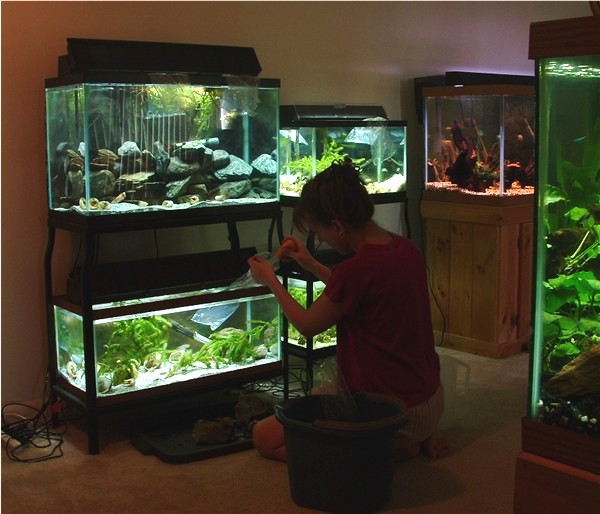How to Hide Fish Tank from Landlord

To hide a fish tank from your landlord, consider placing it in a discreet location or using a room divider. Creating a natural-looking background or using furniture to camouflage the tank can also be effective.

Credit: www.aquariumadvice.com
Ensuring Privacy And Compliance
When considering how to hide a fish tank from your landlord, it is essential to evaluate your lease agreement. Look for any restrictions or clauses that may prevent you from keeping a fish tank in your rental property. Once you have confirmed that it is allowed, choose a suitable location for the tank.
Optimize the tank placement by ensuring it is out of sight from common areas and windows. Additionally, consider using plants or decorative items to camouflage the tank further. Remember to regularly maintain and clean the tank to prevent any odors or water damage that may catch your landlord’s attention.
By following these guidelines, you can enjoy your fish tank in peace while complying with your rental agreement.
Discreet Tank Setup
Setting up a discreet fish tank in your rental space can be accomplished with a few simple strategies. Firstly, opt for a compact aquarium that doesn’t take up much space. This way, it will be easier to hide from your landlord’s view.
Secondly, utilize camouflage techniques to make the fish tank blend in with its surroundings. You can use plants, rocks, or decorative elements to create a natural look that doesn’t attract unnecessary attention. Additionally, employ noise reduction strategies to hide any sound that the fish tank might make.
This can involve using a soundproof mat under the tank or placing it on a stable surface to minimize vibrations. By following these guidelines, you can enjoy your fish tank without worrying about your landlord discovering it.
Maintenance And Care
Regular cleaning is essential for maintaining a hidden fish tank from your landlord. A proper filtration system is crucial in keeping the water clean and free from odor. It is important to establish a regular schedule for cleaning the tank and performing maintenance tasks.
Cleaning the tank on a weekly basis, including scrubbing the glass, removing debris, and vacuuming the gravel, helps to prevent buildup and keeps the tank looking its best. Additionally, checking and cleaning the filter regularly ensures that it is functioning properly.
Managing aquarium odors can be achieved by using activated carbon filters, adding live plants, and controlling the amount of food given to the fish. By following these steps, you can maintain a clean and odor-free fish tank while concealing it from your landlord.
Additional Tips And Considerations
When hiding a fish tank from your landlord, there are a few additional tips and considerations to keep in mind. To start, it’s important to keep noise levels low to avoid drawing unwanted attention. This can be done by investing in a quiet filter system and using a rubber mat to dampen any vibrations.
Another consideration is addressing potential damage. Protect your floors by placing a waterproof mat under the tank and regularly inspect for leaks or cracks. Lastly, maintain open communication with your landlord. If hiding the fish tank is against the lease agreement, it’s best to discuss any concerns or potential compromises.
Overall, taking these precautions will help ensure a successful and hassle-free experience with your hidden fish tank.
Frequently Asked Questions For How To Hide Fish Tank From Landlord
What Can I Put In My Tank For Fish To Hide?
For fish to hide in your tank, you can add various hiding spots and decorations. Use aquatic plants like java moss, anubias, or vallisneria, which not only provide cover but also enhance the tank’s aesthetic appeal. Add rocks, caves, or driftwood, which create caves and crevices for fish to hide in.
You can also include pvc pipes or terra cotta pots with openings for them to swim through. These artificial shelters mimic natural hiding places and make your fish feel secure. It’s important to keep in mind the size and compatibility of your fish when selecting hiding spots.
Ensure that the decor doesn’t have sharp edges that could harm your fish. Providing hiding places promotes their well-being and reduces stress, so they can thrive in your tank.
Where Is The Best Place To Put A Fish Tank In An Apartment?
The best place to put a fish tank in an apartment is away from direct sunlight and heavy foot traffic to minimize stress on the fish. It is important to choose a sturdy and level surface to prevent any accidents.
Also, avoid placing the tank near any heat sources or drafts. Adequate space around the tank is essential for proper maintenance. Make sure there is easy access to electrical outlets for the aquarium equipment. Consider placing the tank in a room where the temperature and humidity are stable for the well-being of the fish.
Additionally, placing the aquarium near a water source can make water changes and cleaning more convenient. Remember to check and comply with any building or rental regulations regarding aquarium placement in an apartment.
Where Should You Not Put An Aquarium In Your House?
An aquarium should not be placed in these areas of your house: 1. Direct sunlight exposure can cause rapid temperature fluctuations and excessive algae growth. 2. Avoid places with high traffic or frequent disturbances that can stress the aquatic life.
3. Keep the aquarium away from windows or doors to prevent drafts, temperature variations, and accidental bumps. 4. Also, avoid placing it near air conditioning or heating vents as this can disrupt the tank’s temperature stability. By following these guidelines, you will ensure a suitable environment for your aquarium, helping to maintain the health and well-being of its inhabitants.
How Do You Hide A Fish Tank Stand?
To hide a fish tank stand, you can choose from various methods. Using a decorative aquarium cabinet or stand that matches your home decor is popular. Alternatively, you can disguise the stand by placing a curtain or fabric around it.
Another option is to incorporate the stand into a larger furniture piece, such as a bookshelf or entertainment center. One creative idea is to build a custom enclosure around the stand using materials like wood or acrylic panels. Additionally, you can hide the stand behind a room divider or tall plants.
Remember to consider factors like accessibility, ventilation, and stability when implementing any hiding method. Experiment and find a solution that meets your needs while creating an aesthetically pleasing setup for your fish tank.
Conclusion
Overall, hiding a fish tank from your landlord may seem like a daunting task, but with some creativity and careful planning, it is definitely possible. Remember to choose a suitable location that is inconspicuous and won’t cause any damage to the property.
Utilize camouflage techniques such as using decorative items, plants, or curtains to blend the tank seamlessly into the surroundings. Additionally, ensure proper maintenance and cleanliness of the tank to avoid any potential issues. Communication is key, so if you feel comfortable, consider discussing your plans with your landlord to see if there are any alternatives or compromises that can be made.
Finally, always be respectful of your lease agreement and the regulations set forth by your landlord. By following these tips, you can enjoy having a fish tank in your home without any hassle or conflicts with your landlord.
